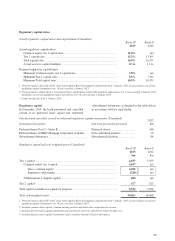HSBC 2013 Annual Report Download - page 46
Download and view the complete annual report
Please find page 46 of the 2013 HSBC annual report below. You can navigate through the pages in the report by either clicking on the pages listed below, or by using the keyword search tool below to find specific information within the annual report.
Cash flows within three months (Unaudited)
2013
$m
2012
$m
Interbank and intra-Group loans and deposits ............................................................... 855 (573)
Reverse repo, repo and outright short positions (including intra-Group) ...................... 1,057 (750)
Contingent liquidity risk arising from committed
lending facilities
The bank provides commitments to various counterparts.
In terms of liquidity risk, the most significant risk relates
to committed lending facilities which, whilst undrawn,
give rise to contingent liquidity risk, as these could be
drawn during a period of liquidity stress. Commitments
are given to customers and committed lending facilities
are provided to conduits, established to enable clients to
access a flexible market-based source of finance.
The table below shows the level of undrawn
commitments outstanding to conduits and customers for
the five largest single facilities and the largest market sector.
The bank’s contractual undrawn exposures monitored under the contingent liquidity risk structure (Unaudited)
2013
$m
2012
$m
Commitments to conduits
Total lines ................................................................................................................. 1,035 940
Largest individual lines ............................................................................................ 765 765
Commitments to customers
Five largest ............................................................................................................... 1,553 1,733
Largest market sector ............................................................................................... 3,644 4,434
Sources of funding
Current accounts and savings deposits, payable on
demand or on short notice, form a significant part of
our funding. We place considerable importance on
maintaining the stability and growth of these deposits,
which provide a diversified pool of funds.
We also access professional markets in order to
maintain a presence in local money markets and to
optimize the funding of asset maturities not naturally
matched by core deposit funding. As part of our
wholesale funding arrangements, we have a number
of programs for fundraising activities, so that undue
reliance is not placed on any one source of funding.
No reliance is placed on unsecured money market
wholesale funding as a source of core funding. Only
wholesale funding with a residual term to maturity of
one year or greater is counted towards the core funding
base. In addition, our stress testing assumptions require
an equivalent amount of liquid assets to be held against
wholesale funding maturing within the relevant stress
testing horizon.
Management’s Discussion and Analysis (continued)
HSBC BANK CANADA
44
























